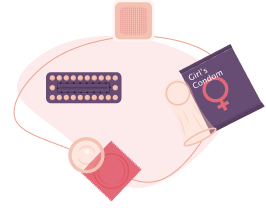
Copper-based Intrauterine Contraceptive System
A copper-based intrauterine contraceptive device (IUCD) is a small device made with copper that is inserted into the uterine cavity to prevent pregnancy for upto 12years.
How it works
Copper IUCDs work to prevent pregnancy by releasing copper in the uterus and preventing fertilization.Effectiveness
- When inserted correctly, Copper-based IUCDs provide 99% effectiveness.
Advantages
- Copper IUCDs have high effectiveness and safety and provide immediate protection after insertion.
- They provide long-acting protection against pregnancy for up to 12 years.
- In addition, IUCDs do not require client action for efficacy.
- Copper-based IUCDs can be used immediately after delivery.
- There is an immediate return to fertility upon removal of the device.
- Copper-based IUCDs are effective as an emergency contraceptive if inserted within 5 days of unprotected sexual intercourse.
- Can be used when breastfeeding.
- It is not affected by other medications.


Limitations
- Insertion and removal of IUCDs must be done at a health facility by a trained medical professional.
- Small risk of infection at insertion and expulsion.
- Does not protect against HIV infection (AIDS) and other STIs.
Side Effects experienced by some users
- Some bleeding or spotting after insertion (may continue for 3 to 6 months)
- Cramping and pain for a few days after insertion
- Changes in bleeding patterns including prolonged and heavy monthly bleeding, irregular bleeding (especial in the first 3 to 6 months after insertion)

Juu life ni kujipanga!
Popular questions
You will get a small injection on your arm to numb you. This means you won’t feel pain at all during insertion. There will be a little pain or soreness as the wound heals for about a week.
Yes. A woman who has not had children generally can use an IUD, but she should understand that the IUD is more likely to come out because her uterus may be smaller than the uterus of a woman who has given birth.
Yes. If needed, ECPs can be taken again, even in the same cycle. A woman who needs ECPs often may want to consider a longer-acting and more effective family planning method
Yes. A woman who has not had children generally can use an IUD, but she should understand that the IUD is more likely to come out because her uterus may be smaller than the uterus of a woman who has given birth.
No. Most research finds no major changes in bleeding patterns after female sterilization. If a woman was using a hormonal method or IUD before sterilization, her bleeding pattern will return to the way it was before she used these methods



